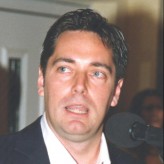A very interesting paper by Oskin et al. (2012) published in Science (http://www.sciencemag.org/content/335/6069/702.full) a few days ago shows how the M 7.2 Mexico earthquake in April, 2010, has changed the landscape down to a few cm. The El Mayor–Cucapah earthquake produced a 120-kilometer-long multifault rupture through northernmost Baja California, Mexico.

Differential LiDAR and cross section. Elevation difference map and cross section showing the distributed deformation as slip steps from the NW Borrego fault into the Paso Inferior accommodation zone (from Oskin et al. (2012).
In the image above and video link below, blue means the earth has descended whereas red shows uplift. This region was scanned before the earthquake following a survey in 2006, permitting a comparison with the post-earthquake record. This study proved very important for this type of earthquake, because strain was distributed and displacement didn’t happen on a major fault line, but through a series of several smaller faults. Learning how such areas behave can provide important insights to seismic hazard assessment. The postevent survey reveals numerous surface ruptures, including previously undocumented blind faults within thick sediments of the Colorado River delta. Differential elevation changes show distributed, kilometer-scale bending strains as large as ~103 microstrains in response to slip along discontinuous faults cutting crystalline bedrock of the Sierra Cucapah. According to the authors due to this unaccounted deformation paleoseismic measurements might underestimate fault slip rates at depth and in addition to slip rate, maximum earthquake size may also be misjudged due to incomplete knowledge of the linkages between faults.
Here is the 3D visualization of the earthquake zone based on differential LiDAR




Christoph | 2012-02-13|11:40 (UTC)
This also explains nicely why paleoseismic trenching can be a very hard business. Just think you do not trench the main fault with the greatest offset but a minor one. You’ll probably assume a minor event only. Even if you trench the one with the largest offset, you’ll miss some total displacement, too. Thus, your results will underestimate the event and you might not even notice an active fault close to the major one.